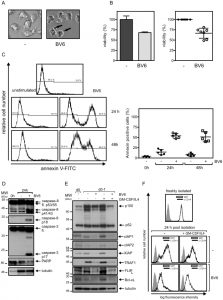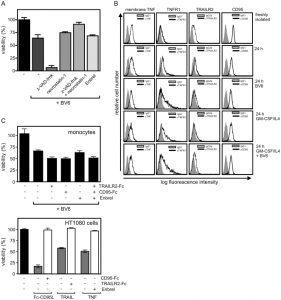
| Size | Price | Stock | Qty |
|---|---|---|---|
| 2mg |
|
||
| 5mg |
|
||
| 10mg |
|
||
| 25mg |
|
||
| 50mg |
|
||
| 100mg |
|
||
| 250mg |
|
||
| Other Sizes |
|
Purity: ≥98%
BV-6 is a novel and potent SMAC (second mitochondrial-derived activator of caspases) mimetic, and a dual inhibitor of cIAP (inhibitor of apoptosis) and XIAP (X-linked inhibitor of apoptosis) with potential anticancer activity. It works by stimulating the differentiation of glioblastoma cancer stem cells by turning on NF-κB.
| Targets |
cIAP; XIAP
|
||
|---|---|---|---|
| ln Vitro |
Inducing apoptosis in both HCC193 and H460 cell lines, BV6 also significantly increases the radiosensitivity of these cell lines by activating cleaved caspase-8 and cleaved caspase-9, respectively. BV6 inhibits the cell viability of HCC193 NSCLC cells with an IC50 of 7.2 μM. [1]
The traditional NF-kB pathway is moderately activated in immature dendritic cells after BV-6 treatment.[2] Additionally, BV-6 increases the CIK cell-mediated lysis of solid malignancies (RH1, RH30, and TE671) as well as hematological malignancies (H9, THP-1, and Tanoue). Additionally, BV-6 increases the apoptosis of peripheral blood mononuclear cells and, most significantly, inhibits immune cells, reducing their capacity for cytotoxicity.[3] |
||
| ln Vivo |
Murine cIAP-1, cIAP-2 and XIAP expressions are clearly observed in the cytoplasm of both epithelial and stromal cells of implants, whereas Survivin is mainly expressed in the nuclei BV6 treatment for 4 weeks attenuated the intensity of IAPs expression. Lesions can be anywhere between 2 and 7 mm in diameter. The cyst's monolayer epithelial cell lining is visible. Vimentin and cytokeratin are positively stained after immunohistochemical staining, but calretinin is negatively stained. The total number of lesions (4.6 versus 2.8/mouse), average weight (78.1 versus 32.0 mg/mouse), and surface area (44.5 versus 24.6 mm2/mouse) of lesions are all significantly lower than in the control group after 4 weeks of BV6 treatment. In the endometrial gland epithelia or stroma, the percentage of Ki67-positive cells decreases after BV6 treatment.
|
||
| Cell Assay |
The CellTiter 96® Aqueous Non-Radioactive Cell Proliferation Assay kit is used to assess cell viability. In triplicate, 96-well plates are seeded with 5000 cells per well. Different wells are then filled with BV6 in varying concentrations after the cells have adhered to them. The same amount of DMSO is administered to the control groups. 24 hours later, the final doses of 333 μg/mL MTS and 25 μM PMS are added to each well. Plates are read at 490 nm on a microplate reader after two hours of incubation at 37 °C in humidified 5% CO2. By comparing the absorbance of each sample to that of the corresponding control, one can determine the relative cell viability of each one. Using Prism 5.01, the IC50 values are determined. Cells are exposed to 1 and 5 μM BV6 with or without 10 μg/mL infliximab for the TNFα-neutralizing antibody assay, which is then conducted 24 hours later. Using a microplate reader, plates are read at 490 nm absorbance.
|
||
| Animal Protocol |
|
||
| References |
| Molecular Formula |
C70H96N10O8
|
|
|---|---|---|
| Molecular Weight |
1205.57
|
|
| Exact Mass |
1,204.74
|
|
| Elemental Analysis |
C, 69.74; H, 8.03; N, 11.62; O, 10.62
|
|
| CAS # |
1001600-56-1
|
|
| Related CAS # |
|
|
| Appearance |
A crystalline solid
|
|
| SMILES |
C[C@@H](C(=O)N[C@@H](C1CCCCC1)C(=O)N2CCC[C@H]2C(=O)N[C@@H](C(C3=CC=CC=C3)C4=CC=CC=C4)C(=O)NCCCCCCNC(=O)[C@H](C(C5=CC=CC=C5)C6=CC=CC=C6)NC(=O)[C@@H]7CCCN7C(=O)[C@H](C8CCCCC8)NC(=O)[C@H](C)NC)NC
|
|
| InChi Key |
DPXJXGNXKOVBJV-YLOPQIBLSA-N
|
|
| InChi Code |
InChI=1S/C70H96N10O8/c1-47(71-3)63(81)75-59(53-37-21-11-22-38-53)69(87)79-45-27-41-55(79)65(83)77-61(57(49-29-13-7-14-30-49)50-31-15-8-16-32-50)67(85)73-43-25-5-6-26-44-74-68(86)62(58(51-33-17-9-18-34-51)52-35-19-10-20-36-52)78-66(84)56-42-28-46-80(56)70(88)60(54-39-23-12-24-40-54)76-64(82)48(2)72-4/h7-10,13-20,29-36,47-48,53-62,71-72H,5-6,11-12,21-28,37-46H2,1-4H3,(H,73,85)(H,74,86)(H,75,81)(H,76,82)(H,77,83)(H,78,84)/t47-,48-,55-,56-,59-,60-,61-,62-/m0/s1
|
|
| Chemical Name |
(2S)-1-[(2S)-2-cyclohexyl-2-[[(2S)-2-(methylamino)propanoyl]amino]acetyl]-N-[(2S)-1-[6-[[(2S)-2-[[(2S)-1-[(2S)-2-cyclohexyl-2-[[(2S)-2-(methylamino)propanoyl]amino]acetyl]pyrrolidine-2-carbonyl]amino]-3,3-diphenylpropanoyl]amino]hexylamino]-1-oxo-3,3-diphenylpropan-2-yl]pyrrolidine-2-carboxamide
|
|
| Synonyms |
Smac mimetic BV6; BV6; BV-6; BV 6
|
|
| HS Tariff Code |
2934.99.9001
|
|
| Storage |
Powder -20°C 3 years 4°C 2 years In solvent -80°C 6 months -20°C 1 month |
|
| Shipping Condition |
Room temperature (This product is stable at ambient temperature for a few days during ordinary shipping and time spent in Customs)
|
| Solubility (In Vitro) |
|
|---|
| Preparing Stock Solutions | 1 mg | 5 mg | 10 mg | |
| 1 mM | 0.8295 mL | 4.1474 mL | 8.2948 mL | |
| 5 mM | 0.1659 mL | 0.8295 mL | 1.6590 mL | |
| 10 mM | 0.0829 mL | 0.4147 mL | 0.8295 mL |
*Note: Please select an appropriate solvent for the preparation of stock solution based on your experiment needs. For most products, DMSO can be used for preparing stock solutions (e.g. 5 mM, 10 mM, or 20 mM concentration); some products with high aqueous solubility may be dissolved in water directly. Solubility information is available at the above Solubility Data section. Once the stock solution is prepared, aliquot it to routine usage volumes and store at -20°C or -80°C. Avoid repeated freeze and thaw cycles.
Calculation results
Working concentration: mg/mL;
Method for preparing DMSO stock solution: mg drug pre-dissolved in μL DMSO (stock solution concentration mg/mL). Please contact us first if the concentration exceeds the DMSO solubility of the batch of drug.
Method for preparing in vivo formulation::Take μL DMSO stock solution, next add μL PEG300, mix and clarify, next addμL Tween 80, mix and clarify, next add μL ddH2O,mix and clarify.
(1) Please be sure that the solution is clear before the addition of next solvent. Dissolution methods like vortex, ultrasound or warming and heat may be used to aid dissolving.
(2) Be sure to add the solvent(s) in order.
 SMAC mimetic BV6 induces cell death in monocytes. |
|---|
 |